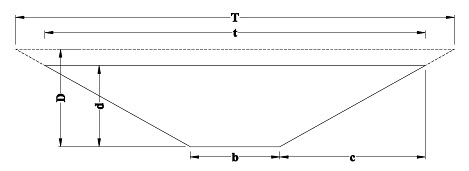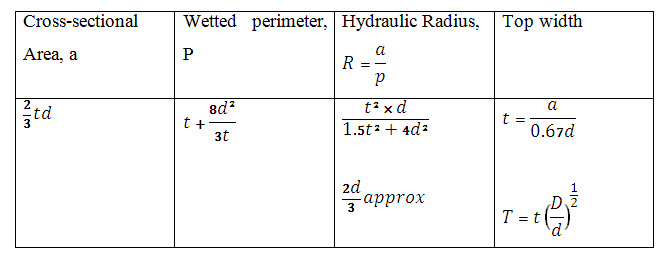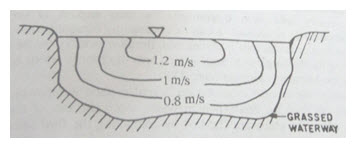Site pages
Current course
Participants
General
Module 1: Introduction and Concept of Soil Erosion
Module 2: Water Erosion and Control
Module 3: Wind Erosion, Estimation and Control
Module 4: Soil Loss- Sediment Yield Estimation
Module 5: Sedimentation
Module 6: Topographic Survey and Contour Maps
Module 7: Land Use Capability Classification
Module 8: Grassed Waterways
Module 9: Water Harvesting
Module 10: Water Quality and Pollution
Lesson 27 Grassed Waterways
Grassed waterways are natural or man made constructed channels established for the transport of concentrated flow at safe velocities from the catchment using adequate erosion resistant vegetation which cover the channels. These channels are used for the safe disposal of excess runoff from the crop lands to some safe outlet, namely rivers, reservoirs, streams etc. without causing soil erosion. Terraced and bunded crop lands, diversion channels, spillways, contour furrows, etc. from which excess runoff is to be disposed of, preferably use constructed grassed waterways for safe disposal of the runoff. The grassed waterways outlets are constructed prior to the construction of terraces, bunds etc. because grasses take time to get established on the channel bed. Generally, it is recommended that there should be a gap of one year so that the grasses can be established during the rainy season.
27.1 Purpose of Grassed Waterways
Grassed waterways are used as outlets to prevent rill and gully formation. The vegetative cover slows the water flow, minimizing channel surface erosion. When properly constructed, grassed waterways can safely transport large water flows to the down slope. These waterways can also be used as outlets for water released from contoured and terraced systems and from diverted channels. This best management practice can reduce sedimentation of nearby water bodies and pollutants in runoff. The vegetation improves the soil aeration and water quality (impacting the aquatic habitat) due to its nutrient removal (nitrogen, phosphorus, herbicides and pesticides) through plant uptake and sorption by soil. The waterways can also provide a wildlife habitat.
27.2 Design of Grassed Waterways
The designs of the grassed waterways are similar to the design of the irrigation channels and are designed based on their functional requirements. Generally, these waterways are designed for carrying the maximum runoff for a 10- year recurrence interval period. The rational formula is invariably used to determine the peak runoff rate. Waterways can be shorter in length or sometimes, can be even very long. For shorter lengths, the estimated flow at the waterways outlets forms the design criterion, and for longer lengths, a variable capacity waterway is designed to account for the changing drainage areas.
27.2.1 Size of Waterway
The size of the waterway depends upon the expected runoff. A 10 year recurrence interval is used to calculate the maximum expected runoff to the waterway. As the catchment area of the waterway increases towards the outlet, the expected runoff is calculated for different reaches of the waterway and used for design purposes. The waterway is to be given greater cross-sectional area towards the outlet as the amount of water gradually increases towards the outlet. The cross-sectional area is calculated using the following formula:

where, a = cross-sectional area of the channel,
Q = expected maximum runoff, and
V = velocity of flow.
27.2.2 Shape of Water Way
The shape of the waterway depends upon the field conditions and type of the construction equipment used. The three common shapes adopted are trapezoidal, triangular, and parabolic shapes. In course of time due to flow of water and sediment depositions, the waterways assume an irregular shape nearing the parabolic shape. If the farm machinery has to cross the waterways, parabolic shape or trapezoidal shape with very flat side slopes are preferred. The geometric characteristics of different waterways are shown in Fig. 27.1 and Fig. 27.2 for trapezoidal and parabolic waterways respectively.

Fig. 27.1. Trapezoidal Cross-section. (Source: Murty, 2009)
In the figure, d is the depth of water flow, b is bottom width, t is the top width of maximum water conveyance, T is top width after considering free board depth, (D - d) is the free board and slope (z) is c/d.
The design dimensions for trapezoidal and parabolic waterways are given in Tables 27.1 and 27.2 respectively.
Table 27.1. Design Dimensions for Trapezoidal Cross-section


Fig. 27.2. Parabolic Cross-section. (Source: Murty, 2009)
Table 27.2. Design Dimensions for Parabolic Cross-Section

27.2.3 Channel Flow Velocity
The velocity of flow in a grassed waterway is dependent on the condition of the vegetation and the soil erodibility. It is recommended to have a uniform cover of vegetation over the channel surface to ensure channel stability and smooth flow. The velocity of flow through the grassed waterway depends upon the ability of the vegetation in the channel to resist erosion. Even though different types of grasses have different capabilities to resist erosion; an average of 1.0 m/sec to 2.5 m/sec are the average velocities used for design purposes. It may be noted that the average velocity of flow is higher than the actual velocity in contact with the bed of the channel. Velocity distribution in a grassed lined channel is shown in Fig. 27.3. Recommended velocities of flow based on the type of vegetation are shown in Table 27.3. The permissible velocities of flow on different types of soils are given in table 27.4.

Fig. 27. 3. Velocity Distribution in Open Channel (Source: Murty, 2009)
Table 27.3. Recommend Velocities of Flow in a Vegetated Channel.
|
Type of vegetation cover |
Flow velocity, (m/s) |
|
|
Type |
Magnitude |
|
|
Spare green cover |
Low velocity |
1-1.15 |
|
Good quality cover |
Medium velocity |
1.5-1.8 |
|
Excellent quality cover |
High velocity |
1.8-2.5 |
Table 27.4. Permissible Velocity of Flow on Different Types of Soil. (Source: V.V.N. Murty)
|
Type of soil |
Permissible velocity, (m/s) |
|
|
Clean water |
Colloidal water |
|
|
Very fine sand |
0.45 |
0.75 |
|
Sandy loam |
0.55 |
0.75 |
|
Silty loam |
0.60 |
0.90 |
|
Alluvial silt without colloids |
0.60 |
1.00 |
|
Dense clay |
0.75 |
1.00 |
|
Hard clay, colloidal |
1.10 |
1.50 |
|
Very hard clay |
1.80 |
1.80 |
|
Fine gravel |
0.75 |
1.50 |
|
Medium and coarse gravel |
1.20 |
1.80 |
|
Stones |
1.50 |
1.80 |
27.2.4 Design of Cross-Section
The design of the cross-section is done using Equation 27.1 for finding the area required and Manning’s formula is used for cross checking the velocity. A trial procedure is adopted. For required cross-sectional area, the dimensions of the channel section are assumed. Using hydraulic property of the assumed section, the average velocity of flow through the channel cross-section is calculated using the Manning’s formula as below:

where, V = velocity of flow in m/s; S = energy slope in m/m; R = hydraulic mean radius of the section in m and n = Manning’s roughness coefficient.
The Manning’s roughness coefficient is to be selected depending on the existing and proposed vegetation to be established in the bed of the channel. Velocity is not an independent parameter. It will depend on n which is already fixed according to vegetation, R which is a function of the channel geometry and slope S for uniform flow. Slope S has to be adjusted. If the existing land slope gives high velocity, alignment of the channel has to be changed to get the desired velocity.
Problem 27.1: Design a grassed waterway of parabolic shape to carry a flow of 2.6 m3/s down a slope of 3 percent. The waterway has a good stand of grass and a velocity of 1.75 m/s can be allowed. Assume the value of n in Manning’s formula as 0.04.
Solution: Using, Q = AV for a velocity of 1.75 m/s, a cross-section of 2.6/1.75 = 1.485 m2 (~1.5 m2) is needed.
Assuming, t = 4 m, d = 60 cm.

The velocity exceeds the permissible limit. Assuming a revised
t = 6 m and d = 0.4 m

The velocity is within the permissible limit.
Q = 1.6 × 1.7 = 2.72 m3/s
The carrying capacity (Q) of the waterway is more than the required. Hence, the design of waterway is satisfactory. A suitable freeboard to the depth is to be provided in the final dimensions.
27.2.5 Construction of the Waterways
It is advantageous to construct the waterways at least one season before the bunding. It will give time for the grasses to get established in the waterways. First, unnecessary vegetation like shrubs etc. are removed from the area is marked for the waterways. The area is then ploughed if necessary and smoothened. Establishment of the grass is done either by seeding or sodding technique. Maintenance of the waterways is important for their proper operation. Removal of weeds, filling of the patches with grass and proper cutting of the grass are of the common maintenance operations that should be followed for an efficient use of waterways.
27.3 Selection of Suitable Grasses
The soil and climate conditions are the primary factors in selection of vegetations to be established for construction of grassed waterways. The other factors to be considered for selection of suitable grasses are duration of establishment, volume and velocity of runoff, ease of establishment and time required to develop a good vegetative cover. Furthermore, the suitability of the vegetation for utilization as feed or hay, spreading of vegetation to the adjoining fields, cost and availability of seeds and redundancy to shallow flows in relation to the sedimentation are the important factors that should be considered for the selection of vegetation.
Generally, the rhizomatous grasses are preferred for the waterway, because they get spread very quickly and provide more protection to the channel than the brush grasses. Deep rooted legumes are seldom used for grassed waterways, because they have the tendency to loosen the soil and thus make the soil more erodible under the effect of fast flowing runoff water. Sometimes, a light seeding of small grain is also used to develop a quick cover before the grasses are fully established in the waterway.
27.4 Construction Procedure and Maintenance
Ordinary tools such as slip scraper can be easily used for construction of waterways. However, the use of grader blade or a bulldozer can be preferred, particularly when a considerable earth movement is needed. Since the channel is prone to erosion before vegetations are established, it is very essential to construct the waterway when the field is in meadow and the amount of runoff from the area is also very less. In addition, if the erosion hazard is very high, then runoff should also be essentially diverted from the waterway until a good grassed cover is developed in the waterway.
The construction of grassed waterways is carried out using the following steps.
Step-1: Shaping (Soil Digging)
The shaping of the waterway should be done as straight and even as possible. Any sudden fall or sharp turn must be eliminated, except in the area where the structure is planned to be installed in the waterway. In addition, the grade should also be shaped according to the designed plan. Also, the stones and stumps which are likely to interfere with the discharge rate must be removed.
Step-2: Grass Planting
After shaping the waterway channel, the planting of grasses is very important. Priorities should always be given to the local species of grasses. The short forming or rhizome grasses are more preferable as compared to the tall bunch type grasses.
In large waterways, the seeding is cheaper than the sodding. Therefore, the seeding should be preferred for grass development. It is also suggested that the seeded area should be mulched especially for production purposes. Immediately after grass planting, the waterways should not be allowed for runoff flow.
Step 3: Ballasting
Ballasting is done in those localities where rocks are readily available adjacent to the sites and waterway gradient is very steep. Ballasting is generally recommended for the waterways in the small farms. The stones to be used for this purpose should be at least of 15 to 20 cm diameter; and they should be placed firmly on the ground. From stability point of view, on very steep slopes, wire mesh should be used to encase the stones. In parabolic shaped waterways, partial ballasting should be done in the centre, leaving the sides with grass protection.
Step 4: Placing of Structure
Structures (drop) are essential if there is sudden fall in the waterway flow path. Because under this situation, there is a possibility of soil scouring due to falling of water flow from a higher elevation to a lower elevation. For eliminating this problem, the constructed structure must be sufficiently strong to handle the designed flows successfully. As a precautionary measure, care should be taken to see that the water must not flow from the below or around the structure but through the top of the structure. In addition, the structure should be constructed on firm soils with strong and deep foundation. The apron or stilling basin of drop structures should be sufficiently strong and able to absorb or dissipate the energy/impact of falling water. After construction, earth filling should be done around the structure and it should be properly consolidated to prevent further settlement. Proper sodding should also be provided at the junction of earth filling and the structure to prevent tunneling.
27.4.1 Maintenance
The grasses grown in waterway should always be kept short and flexible, so that they shingle as water flows over them, but do not lodge permanently. For this purpose, the grass should be mowed two to three times in a year. The mowed grasses must be removed from the waterway, so that they do not get accumulated at some spots in the waterway and also should not obstruct the flow. The deposition of mowed grasses in the section of the waterway reduces the flow capacity of the waterway and also diverts the direction of flowing water which can cause turbulence and thus damage of the channel. It is also possible to keep the grasses short by light pasturing, which should not be done in wet condition. When the grass is pastured, it is necessary to apply manure to discourage grazing. The waterway should not be used as a road for livestock. After the vegetative cover is established and runoff passes through them for a long time, a light application of fertilizer should be done because the flowing runoff removes the plant food from the soil of waterway.
Similarly, if waterways are to be crossed by tillage implements, they should be disengaged, plough should be lifted and disc straightened. Tillage operation should also be done following nearly the contour. The waterway and its sides should not be touched during tillage operation. It is also essential that if there is any damage of the waterway, it should be quickly repaired so that the damage may not enlarge due to rainfalls. Overall, it should always be remembered that the waterways are an integral part of watershed conservation or land treatment system. If they fail to handle the peak discharge due to lack of proper maintenance, then the prolong flow of runoff through them can develop gullies in the area. Briefly, the maintenance of waterways can be taken up using the following process.
a) The outlets should be safe and open so as not to impede the free flow.
b) Grassed waterways should not be used as footpaths, animal tracks, or as grazing grounds.
c) Frequent crossing of waterways by wheeled vehicles should not be allowed.
d) Newly established waterways should be kept under strict watch.
e) The large waterways should be kept under protection with fencing.
f) Waterways must be inspected frequently during first two rainy seasons, after construction.
g) If there is any break in the channel or structures, then they should be repaired immediately.
h) The bushes or large plants grown in the waterway should be removed immediately as they may endanger the growth of grasses.
i) The level of grass in waterway should be kept as low and uniform as possible to avoid turbulent flow.
Key words: Grassed Waterways, Channel, Ballasting.
References
Das, G. (2004). Hydrology and Soil Conservation Engineering. Prentice-Hall of India Private Limited. New Delhi.
Murty, V.V.N. (2009). Land and Water Management Engineering. Kalyani Publishers, New Delhi.
Suresh, R. (2002). Soil and Water Conservation Engineering. Standard Publishers Distributors, New Delhi.
Suggested Readings
Das, G. (2000). Hydrology and Soil Conservation Engineering, Prentice Hall of India, New Delhi, India.
Mal, B.C. (1994). Introduction to Soil and Water Conservation Engineering, Kalyani Publishers, New Delhi, India
Murty, V.V.N. and Jha, M.K. (2011). Land and Water Management Engineering. Sixth Edition, Kalyani Publishers, Ludhiana.
Sharda, V.N., Juyal, G.P., Prakash, C. and Joshi, B.P. (2007). Soil And Water Conservation Engineering (Training Manual-volume II), CSWCRTI, Dehradun, India.